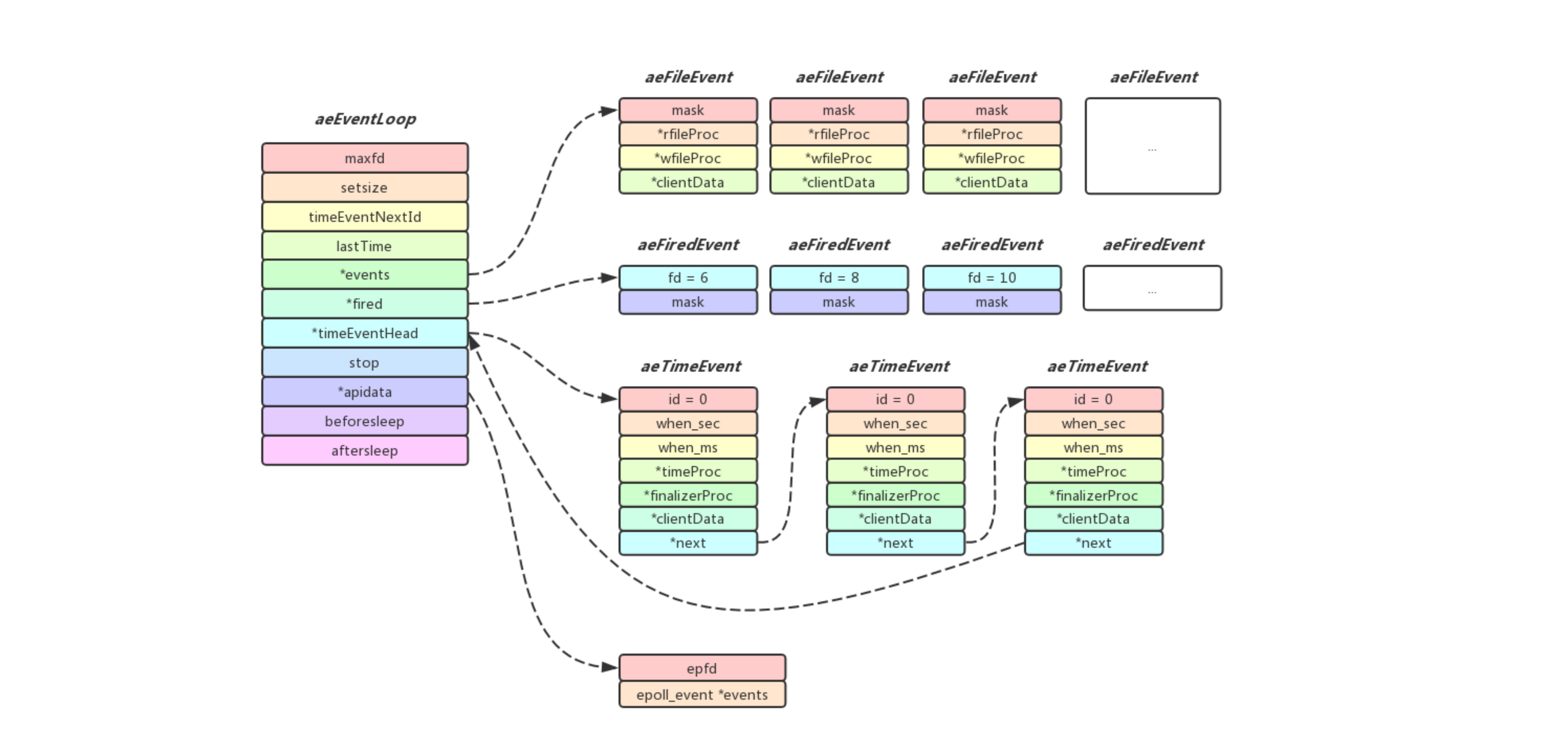
Redis服务器是一个事件驱动程序, 事件是Redis服务器的核心, 它处理两项重要的任务, 一个是IO事件(文件事件), 另外一个是时间事件, Redis服务器通过套接字与客户端进行连接, 而文件事件可以理解为服务器对套接字操作的抽象. 服务器与客户端的通信会产生相应的文件事件, 而服务器则通过监听并处理这些事件来完成一系列网络通信操作, 另外Redis内部有一些操作(从Redis4.0的代码分析目前时间事件只有serverCron)需要在给定的时间点执行, 而时间事件就是Redis服务器对这类定时操作的抽象
在分析具体代码之前, 我们先了解一下在事件处理中处于核心部分的aeEventLoop到底是什么:
/* State of an event based program */
typedef struct aeEventLoop {
int maxfd; /* highest file descriptor currently registered, 当前注册的最大fd数 */
int setsize; /* max number of file descriptors tracked, 允许关注fd数量的上限(就是events和fired数组的大小) */
long long timeEventNextId /* 下一个定时事件的ID */;
time_t lastTime; /* Used to detect system clock skew */
aeFileEvent *events; /* Registered events, 指向aeFileEvent数组, 每个fd都有对应的aeFileEvent对象(fd就是当做下标用于索引)*/
aeFiredEvent *fired; /* Fired events, 指向aeFiredEvent数组, 当检测到有文件事件时, 会将对应的fd和事件存放在数组里面*/
aeTimeEvent *timeEventHead /* 指向首个时间事件结构体, 而时间事件结构体里有next指针, 指向下一个结构体, 实际上整体看上去是一个环形链表(最后一个时间事件结构体里的next指针会指向timeEventHead */;
int stop /* 是否停止event loop循环 */;
void *apidata; /* This is used for polling API specific data, 指向底层不同多路复用实现的数据结构, 可以是epoll, select, evport或者是kqueue */
aeBeforeSleepProc *beforesleep;
aeBeforeSleepProc *aftersleep;
} aeEventLoop;创建aeEventLoop只需要一个setsize参数, 它标识了当前aeEventLoop最大可以监听的文件描述符数(通常redis传入server.maxclients+CONFIG_FDSET_INCR, 也就是在用户指定的最大客户端连接数的基础上再额外增加128, 这128可以用于Redis内部打开AOF, RDB文件以及主从, 集群互相通信所对应的文件句柄), 创建aeEventLoop时, aeFileEvent和aeFiredEvent数组的大小就由setsize确定,
aeApiPoll的时候才会被赋值, 例如当前发现有套接字6, 8有可读事件, 而套接字10有可写事件, 那么fired数组的前三个元素会被赋值{fd = 6, mask = AE_READABLE}, {fd = 8, mask = AE_READABLE}, {fd = 10, mask = AE_WRITABLE}, 紧接着我们以6为索引, 找到文件事件数据结构events[6], 然后发现触发的是可读事件, 我们再调用events[6]中rfileProc来处理可读事件.aeEventLoop *aeCreateEventLoop(int setsize) {
aeEventLoop *eventLoop;
int i;
if ((eventLoop = zmalloc(sizeof(*eventLoop))) == NULL) goto err;
eventLoop->events = zmalloc(sizeof(aeFileEvent)*setsize);
eventLoop->fired = zmalloc(sizeof(aeFiredEvent)*setsize);
if (eventLoop->events == NULL || eventLoop->fired == NULL) goto err;
eventLoop->setsize = setsize;
eventLoop->lastTime = time(NULL);
eventLoop->timeEventHead = NULL;
eventLoop->timeEventNextId = 0;
eventLoop->stop = 0;
eventLoop->maxfd = -1;
eventLoop->beforesleep = NULL;
eventLoop->aftersleep = NULL;
if (aeApiCreate(eventLoop) == -1) goto err;
/* Events with mask == AE_NONE are not set. So let's initialize the
* vector with it. */
for (i = 0; i < setsize; i++)
eventLoop->events[i].mask = AE_NONE;
return eventLoop;
}对于时间事件, aeEventLoop中有一个timeEventHead指针指向第一个时间事件, 由于aeEventLoop创建之初, 内部没有任何时间事件, 所以初始化时timeEventHead指向NULL, 每当有新的时间事件时, 总会被添加到timeEventHead头部, 由于aeTimeEvent结构体中有next指针可以指向下一个aeTimeEvent结构体, 所以只要我们获取timeEventHead就能遍历当前所有的时间事件了, 另外有一个细节需要注意, 最后一个aeTimeEvent结构体中的next指针指向的是timeEventHead, 所以所有时间事件实际上就是由一个环形链表串连起来的.

在介绍中有提到过文件事件实际上就是服务器对套接字操作的抽象, 当套接字有可读\写事件触发的时候, 我们需要调用相应的处理函数, 下面先看一下跟文件事件相关的结构体:
/* File event structure */
typedef struct aeFileEvent {
int mask; /* one of AE_(READABLE|WRITABLE) */
aeFileProc *rfileProc; /* 指向有读事件调用的处理函数 */
aeFileProc *wfileProc; /* 指向有写事件调用的处理函数 */
void *clientData; /* 指向私有数据, 当做可读/可写函数的入参 */
} aeFileEvent;
/* A fired event */
typedef struct aeFiredEvent {
int fd;
int mask;
} aeFiredEvent;在aeEventLoop初始化的时候会为aeFileEvent数组(events)分配空间, 数组的大小由参数setsize指定, 表明了当前Redis最大打开的套接字的大小, 套接字与aeFileEvent一一对应, 也就是说我们可以通过套接字数值作为索引到events数组中找到他对应的aeFileEvent对象
当我们在aeEventLoop中注册一个文件事件时, 首先我们判断传入的套接字对events数组是否有越界行为, 若没有越界行为, 我们便可以获取与当前套接字对应的aeFileEvent对象, 然后调用aeApiAddEvent将当前的文件描述符以及监听的事件注册到底层IO多路复用机制(epoll, select, evport, kqueue其中之一)中, 另外我们还需要指定当可读/可写事件发生时需要调用的函数,另外当前文件事件的一些私有数据被存放在clientData指向的对象当中.
int aeCreateFileEvent(aeEventLoop *eventLoop, int fd, int mask,
aeFileProc *proc, void *clientData)
{
if (fd >= eventLoop->setsize) {
errno = ERANGE;
return AE_ERR;
}
aeFileEvent *fe = &eventLoop->events[fd];
if (aeApiAddEvent(eventLoop, fd, mask) == -1)
return AE_ERR;
fe->mask |= mask;
if (mask & AE_READABLE) fe->rfileProc = proc;
if (mask & AE_WRITABLE) fe->wfileProc = proc;
fe->clientData = clientData;
/* 当前fd如果大于了目前的maxfd, 则需要进行更新 */
if (fd > eventLoop->maxfd)
eventLoop->maxfd = fd;
return AE_OK;
}Redis内部的时间事件实际可以分为两类, 一类是定时事件, 也就是需要在未来某一个时间点触发的事件(只触发一次), 另外一类是周期性事件, 和前面的定时事件只触发一次不同, 周期性事件是每隔一段时间又会重新触发一次.
Redis使用了timeProc指向函数的返回值来判断当前属于哪类事件, 若函数返回AE_NOMORE(也就是-1), 说明当前事件无需再次触发(将id置删除标记AE_DELETED_EVENT_ID), 若函数返回一个大于等于0的值n, 说明再等待n毫秒, 该事件需要再重新被触发(根据返回值更新when_sec和when_ms), 在博客开头提到的serverCron时间事件实际上就是一个周期性事件, 函数末尾会返回1000/server.hz, server.hz默认被设置为10, 也就是说serverCron平均每间隔100ms会被调用一次.
/* Time event structure */
typedef struct aeTimeEvent {
long long id; /* time event identifier, 定时事件的ID */
long when_sec; /* seconds, 定时事件下一次触发的时间(秒) */
long when_ms; /* milliseconds, 定时事件下一次触发的时间(毫秒) */
aeTimeProc *timeProc; /* 指向定时事件发生时的调用函数 */
aeEventFinalizerProc *finalizerProc; /* 指向当当前定时事件被删除时的清理函数 */
void *clientData; /* 指向私有数据, 当做定时事件函数的入参 */
struct aeTimeEvent *next; /* 指向下一个定时事件的指针 */
} aeTimeEvent;
Redis调用aeCreateTimeEvent来创建一个时间任务, 实现非常简单, 传参我们关注一下milliseconds和proc即可, 前者指定了时间事件距离当前的触发时间, 后者指定了时间事件触发时应调用的函数, 内部通过aeAddMillisecondsToNow将当前定时任务触发的时间戳计算出来赋值给when_sec和when_ms, 然后再将timeProc指向时间事件到达时应该调用的函数.
在完成了aeTimeEvent结构体内部变量赋值之后, 最后将其添加到aeEventLoop内部的存储定时间事件的环形链表的头部中(这里需要注意的是, 由于我们总是将新的时间事件加入环形链表的头部, 所以时间事件触发的时间先后并不是在环形链表中有序的, 我们需要将环形链表遍历完毕才能保证当前已经到达的时间事件都已经被处理完毕, 不过由于在开头提到过, 目前Redis只存在serverCron一个时间事件, 所以我们无需担心遍历环形链表影响服务性能), 此时一个时间事件就算创建完成了
static void aeAddMillisecondsToNow(long long milliseconds, long *sec, long *ms) {
long cur_sec, cur_ms, when_sec, when_ms;
aeGetTime(&cur_sec, &cur_ms);
when_sec = cur_sec + milliseconds/1000;
when_ms = cur_ms + milliseconds%1000;
if (when_ms >= 1000) {
when_sec ++;
when_ms -= 1000;
}
*sec = when_sec;
*ms = when_ms;
}
long long aeCreateTimeEvent(aeEventLoop *eventLoop, long long milliseconds,
aeTimeProc *proc, void *clientData,
aeEventFinalizerProc *finalizerProc)
{
long long id = eventLoop->timeEventNextId++;
aeTimeEvent *te;
te = zmalloc(sizeof(*te));
if (te == NULL) return AE_ERR;
te->id = id;
aeAddMillisecondsToNow(milliseconds,&te->when_sec,&te->when_ms);
te->timeProc = proc;
te->finalizerProc = finalizerProc;
te->clientData = clientData;
te->next = eventLoop->timeEventHead;
eventLoop->timeEventHead = te;
return id;
}Redis通过aeDeleteTimeEvent函数来删除一个时间任务, 传参只有一个待删除时间事件的id, 我们发现这里的删除实际上是一种惰性删除, 将aeTimeEvent中的id标记为AE_DELETED_EVENT_ID, 而不是直接将aeTimeEvent对象从链表中删除并且释放, 个人认为这么实现的原因更多是为了安全考虑以及代码的简洁性, 考虑在一个时间事件中本来想删除另外一个时间事件, 但是由于id填错, 误删成自己了, 此时如果释放自身aeTimeEvent对象, 这是十分危险的.
int aeDeleteTimeEvent(aeEventLoop *eventLoop, long long id)
{
aeTimeEvent *te = eventLoop->timeEventHead;
while(te) {
if (te->id == id) {
te->id = AE_DELETED_EVENT_ID;
return AE_OK;
}
te = te->next;
}
return AE_ERR; /* NO event with the specified ID found */
}Redis是单线程的, 内部是一直处于aeMain中的while循环中, 而循环内部不断调用aeProcessEvents函数, 该函数会对上面提到的文件事件和时间事件进行调度, 决定何时处理文件事件以及时间事件 .
void aeMain(aeEventLoop *eventLoop) {
eventLoop->stop = 0;
while (!eventLoop->stop) {
if (eventLoop->beforesleep != NULL)
eventLoop->beforesleep(eventLoop);
aeProcessEvents(eventLoop, AE_ALL_EVENTS|AE_CALL_AFTER_SLEEP);
}
}实际上aeProcessEvents函数内部做的事情也非常简单, 下面进行了梳理:
aeSearchNearestTimer获取到达时间距离当前最近的时间事件struct timeval*指针指向的结构体中(若在步骤一中没有获取到时间事件对象, 那么指针为NULL)id为AE_DELETED_EVENT_ID的代表已经做了删除标记的时间事件, 需要将该时间事件从链表中移除, 并且进行释放, 如遇到已经达到的时间事件, 则调用其绑定的处理函数, 并且根据返回值来判断该事件时间是否需要在给定的时间内再重新触发.Q1: 时间事件触发的时间一定精准么?
A1: 时间事件的触发并不能在指定的时间精准触发, 一般都要比指定的时间稍晚一点, 此外在Redis单线程模型下, 时间事件都是串行执行的, 中间如果某个时间事件处理时间长, 更加影响了后面时间事件执行时间的精准性. 而且时间事件链表是无序的, 所以在极端场景下, 存在优先级低的时间事件比优先级高的事件先触发的可能性, 不过好在目前Redis内部只有一个时间事件, 所以影响不会太大.
Q2: aeEventLoop在创建之初就指定了可监听文件描述符的数量, 之后又通过config set maxclients命令动态调整客户端最大连接数是怎么实现的?
A2: 通过翻看源码了解到, aeEventLoop提供了aeResizeSetSize函数, 用户重新分配events和fired数组的大小, 使aeEventLoop可监听的套接字数量得以调整, 当新的maxclients比原先要大的时候, 会调用该函数, 扩大aeEventLoop可监听文件描述符的数量, 以支持更多的客户端连接.
int aeResizeSetSize(aeEventLoop *eventLoop, int setsize) {
int i;
if (setsize == eventLoop->setsize) return AE_OK;
if (eventLoop->maxfd >= setsize) return AE_ERR;
if (aeApiResize(eventLoop,setsize) == -1) return AE_ERR;
eventLoop->events = zrealloc(eventLoop->events,sizeof(aeFileEvent)*setsize);
eventLoop->fired = zrealloc(eventLoop->fired,sizeof(aeFiredEvent)*setsize);
eventLoop->setsize = setsize;
/* Make sure that if we created new slots, they are initialized with
* an AE_NONE mask. */
for (i = eventLoop->maxfd+1; i < setsize; i++)
eventLoop->events[i].mask = AE_NONE;
return AE_OK;
}Redis对事件的处理方式十分巧妙, 文件事件和时间事件之间相互配合, 充分的利用时间事件达到之前的这段时间等待和处理文件事件, 这样既避免了CPU的空转检查, 也能及时的处理文件事件. 此外通过时间事件中timeProc函数的返回值, 将时间事件的移除和再次触发权完全交给了用户, 使用起来更加灵活.